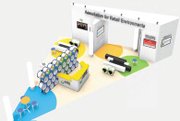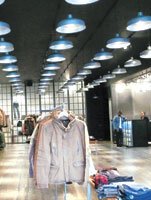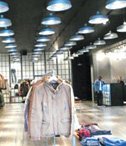Visual Display: Designing a Better Trade Show
David Winston has an antidote to cure the common trade show blues.
“The experience of trade shows can be stressful and overwhelming,” said Winston, the principal of Los Angeles–headquartered Cleanroom Inc. Design Lab. “Convention centers are designed for forklifts; they’re not on a human scale. Our goal is to make shows more hospitable and allow people to connect on a human level through design of the physical environment.”
Winston’s prognosis for a good trade show experience has been embraced by some of America’s top trade show producers. Cleanroom Inc. minted the sometimes-provocative design installations at Project from 2004 to 2010. From 2009 to 2010, the company also designed signage, lounges and furniture for the diverse sections of MAGIC, the trade show giant owned by Advanstar Communications, which also owns Project.
Winston’s ideas for improving trade show design will be on display at GlobalShop, the store-design trade show set for Feb. 28–March 2 at the Sands Expo and Convention Center in Las Vegas.
Architect and retail environments trade group Association for Retail Environments (ARE) selected Winston and Cleanroom to design its booth at the show. Cleanroom’s 600-square-foot ARE booth will be located close to GlobalShop’s entrance. It is intended to be a lounge where people can stop for a few minutes and plan their trip through the show.
The wedge-shaped booth features furniture from Scale1:1, which also is designed by Winston. There’s a round shelving display where people can read ARE literature. The booth also features a wall with plasma screens, suspended track lighting, Internet stations and Winston’s signature finger couches. These long, slender, slab-like couches extend and connect like fingers. They are covered in upholstery typically used in cars and boats. The couches are comfortable and offer lower-back support, and they were crafted that way for more than aesthetic reasons.
People often need a place to rest for a few minutes before planning their next move at a show. “They also can interact without getting too comfortable,” Winston said. A couch with a full back often invites people to lounge for a long period. This sort of furniture is great for a house, but it defeats the purpose of a trade show, where people are supposed to buzz about and make business connections.
Design typically is a secondary consideration for most trade shows, said Susanne Andrey, owner of branded-environments and retail-solutions company Infuse Elements, based in Aliso Viejo, Calif.
“Trade show producers make their business off of the ground, by selling you a piece of concrete,” she said. Andrey helped design booths for exhibitors at MAGIC, ENKWSA and Outdoor Retailer. She is currently working on the look of the Lamb & Flag stores, which are scheduled to debut in mid-December in Southern California.
Many trade show producers do not have the budget to improve their show’s design. Pharmaceutical trade shows and fashion trade shows such as MAGIC are considered by many in the design industry to have the best booths, Andrey said.
In stores now
After a long sojourn in trade show design, Cleanroom has begun working on store environments. In October, it wrapped up the design of Atrium and Kith boutiques in Brooklyn, N.Y. It also is working on the downtown Manhattan locations of Atrium and Kith, which are opening in November.
Atrium is the boutique chain owned by Project founder Sam Ben-Avraham. (Advanstar purchased Project from Ben-Avraham in 2005.) The Atrium shop is connected to Kith, a new footwear concept put together by footwear designer Ronnie Fieg. Cleanroom also worked with Mexico City–based denim company Sxy Jns on the redesign of its company store at the Parque Interlomas retail center in Mexico City. The shop will be a template for five other Sxy Jns stores around Mexico City. The company is considering a rollout of stores into other Latin American countries.
Winston said the best strategy to building successful store environments is to create an interesting look but to not overdo it. “Sometimes stores can be too heavy handed with designs,” he said. “The store becomes a monument to the brand, and it doesn’t create a connection with the customer. Retailers seek designers who can create chemistry and loyalty with customers, which converts into sales.”
























